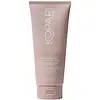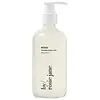What's inside
What's inside
 Key Ingredients
Key Ingredients

 Benefits
Benefits

 Concerns
Concerns

 Ingredients Side-by-side
Ingredients Side-by-side

Water
Skin ConditioningSodium C14-16 Olefin Sulfonate
CleansingCocamidopropyl Betaine
CleansingSodium Chloride
MaskingSodium Methyl Cocoyl Taurate
CleansingAcrylates Copolymer
Polysorbate 20
EmulsifyingBenzyl Alcohol
PerfumingParfum
MaskingPhenoxyethanol
PreservativeCocamide Mipa
EmulsifyingEthylhexylglycerin
Skin ConditioningAloe Barbadensis Leaf Juice
Skin ConditioningGlycerin
HumectantSodium Hydroxide
BufferingSodium Gluconate
Skin ConditioningCocos Nucifera Water
MaskingCoumarin
PerfumingLaminaria Digitata Extract
Skin ProtectingTocopherol
AntioxidantCocos Nucifera Fruit Juice
EmollientSodium Benzoate
MaskingPotassium Sorbate
PreservativeCitric Acid
BufferingSodium Ferrocyanide
Water, Sodium C14-16 Olefin Sulfonate, Cocamidopropyl Betaine, Sodium Chloride, Sodium Methyl Cocoyl Taurate, Acrylates Copolymer, Polysorbate 20, Benzyl Alcohol, Parfum, Phenoxyethanol, Cocamide Mipa, Ethylhexylglycerin, Aloe Barbadensis Leaf Juice, Glycerin, Sodium Hydroxide, Sodium Gluconate, Cocos Nucifera Water, Coumarin, Laminaria Digitata Extract, Tocopherol, Cocos Nucifera Fruit Juice, Sodium Benzoate, Potassium Sorbate, Citric Acid, Sodium Ferrocyanide
Water
Skin ConditioningSodium C14-16 Olefin Sulfonate
CleansingDisodium Cocoamphodiacetate
CleansingCocamide Dipa
EmulsifyingGlycerin
HumectantSodium Chloride
MaskingCaprylyl Glycol
EmollientCitric Acid
BufferingHydroxypropyl Methylcellulose
Emulsion StabilisingAloe Barbadensis Leaf Juice
Skin ConditioningSodium Dehydroacetate
PreservativeTocopheryl Acetate
AntioxidantAlthaea Officinalis Root Extract
Skin ConditioningAvena Sativa Kernel Extract
AbrasiveCalendula Officinalis Flower Extract
MaskingCamellia Sinensis Extract
AntioxidantChamomilla Recutita Extract
Skin ConditioningLavandula Angustifolia Extract
Skin ConditioningPrunus Amygdalus Dulcis Fruit Extract
Skin ConditioningTrifolium Pratense Extract
Skin ConditioningCamellia Sinensis Leaf Extract
AntimicrobialGlycyrrhiza Glabra Root Extract
BleachingHedychium Spicatum Extract
Skin ConditioningOlea Europaea Leaf Extract
PerfumingPinus Pinaster Bark Extract
AntioxidantPunica Granatum Extract
AstringentRosmarinus Officinalis Leaf Extract
AntimicrobialTheobroma Cacao Extract
Skin ConditioningVitis Vinifera Seed Extract
AntimicrobialWater, Sodium C14-16 Olefin Sulfonate, Disodium Cocoamphodiacetate, Cocamide Dipa, Glycerin, Sodium Chloride, Caprylyl Glycol, Citric Acid, Hydroxypropyl Methylcellulose, Aloe Barbadensis Leaf Juice, Sodium Dehydroacetate, Tocopheryl Acetate, Althaea Officinalis Root Extract, Avena Sativa Kernel Extract, Calendula Officinalis Flower Extract, Camellia Sinensis Extract, Chamomilla Recutita Extract, Lavandula Angustifolia Extract, Prunus Amygdalus Dulcis Fruit Extract, Trifolium Pratense Extract, Camellia Sinensis Leaf Extract, Glycyrrhiza Glabra Root Extract, Hedychium Spicatum Extract, Olea Europaea Leaf Extract, Pinus Pinaster Bark Extract, Punica Granatum Extract, Rosmarinus Officinalis Leaf Extract, Theobroma Cacao Extract, Vitis Vinifera Seed Extract
Ingredients Explained
These ingredients are found in both products.
Ingredients higher up in an ingredient list are typically present in a larger amount.
Aloe Barbadensis Leaf Juice comes from leaves of the aloe plant. Aloe Barbadensis Leaf Juice is best known for helping to soothe sunburns. It is also anti-inflammatory, moisturizing, antiseptic, and can help heal wounds.
Aloe is packed with good stuff including Vitamins A, C, and E. These vitamins are antioxidants, which help fight free-radicals and the damage they may cause. Free-radicals are molecules that may damage your skin cells, such as pollution.
Aloe Barbadensis Leaf Juice also contains sugars. These sugars come in the form of monosaccharides and polysaccharides, folic acid, and choline. These sugars are able to help bind moisture to skin.
It also contains minerals such as calcium, 12 anthraquinones, fatty acids, amino acids, and Vitamin B12.
Learn more about Aloe Barbadensis Leaf JuiceCitric Acid is an alpha hydroxy acid (AHA) naturally found in citrus fruits like oranges, lemons, and limes.
Like other AHAs, citric acid can exfoliate skin by breaking down the bonds that hold dead skin cells together. This helps reveal smoother and brighter skin underneath.
However, this exfoliating effect only happens at high concentrations (20%) which can be hard to find in cosmetic products.
Due to this, citric acid is usually included in small amounts as a pH adjuster. This helps keep products slightly more acidic and compatible with skin's natural pH.
In skincare formulas, citric acid can:
While it can provide some skin benefits, research shows lactic acid and glycolic acid are generally more effective and less irritating exfoliants.
Most citric acid used in skincare today is made by fermenting sugars (usually from molasses). This synthetic version is identical to the natural citrus form but easier to stabilize and use in formulations.
Read more about some other popular AHA's here:
Learn more about Citric AcidGlycerin is already naturally found in your skin. It helps moisturize and protect your skin.
A study from 2016 found glycerin to be more effective as a humectant than AHAs and hyaluronic acid.
As a humectant, it helps the skin stay hydrated by pulling moisture to your skin. The low molecular weight of glycerin allows it to pull moisture into the deeper layers of your skin.
Hydrated skin improves your skin barrier; Your skin barrier helps protect against irritants and bacteria.
Glycerin has also been found to have antimicrobial and antiviral properties. Due to these properties, glycerin is often used in wound and burn treatments.
In cosmetics, glycerin is usually derived from plants such as soybean or palm. However, it can also be sourced from animals, such as tallow or animal fat.
This ingredient is organic, colorless, odorless, and non-toxic.
Glycerin is the name for this ingredient in American English. British English uses Glycerol/Glycerine.
Learn more about GlycerinSodium C14-16 Olefin Sulfonate is a cleansing agent made from a mixture of long chain sulfonate salts. It can also help produce foam.
This ingredient may be drying. We recommend speaking with a professional if you have concerns.
Chances are, you eat sodium chloride every day. Sodium Chloride is also known as table salt.
This ingredient has many purposes in skincare: thickener, emulsifier, and exfoliator.
You'll most likely find this ingredient in cleansers where it is used to create a gel-like texture. As an emulsifier, it also prevents ingredients from separating.
There is much debate on whether this ingredient is comedogenic. The short answer - comedogenic ratings don't tell the whole story. Learn more about comegodenic ratings here.
The concensus about this ingredient causing acne seems to be divided. Research is needed to understand if this ingredient does cause acne.
Scrubs may use salt as the primary exfoliating ingredient.
Learn more about Sodium ChlorideWater. It's the most common cosmetic ingredient of all. You'll usually see it at the top of ingredient lists, meaning that it makes up the largest part of the product.
So why is it so popular? Water most often acts as a solvent - this means that it helps dissolve other ingredients into the formulation.
You'll also recognize water as that liquid we all need to stay alive. If you see this, drink a glass of water. Stay hydrated!
Learn more about Water